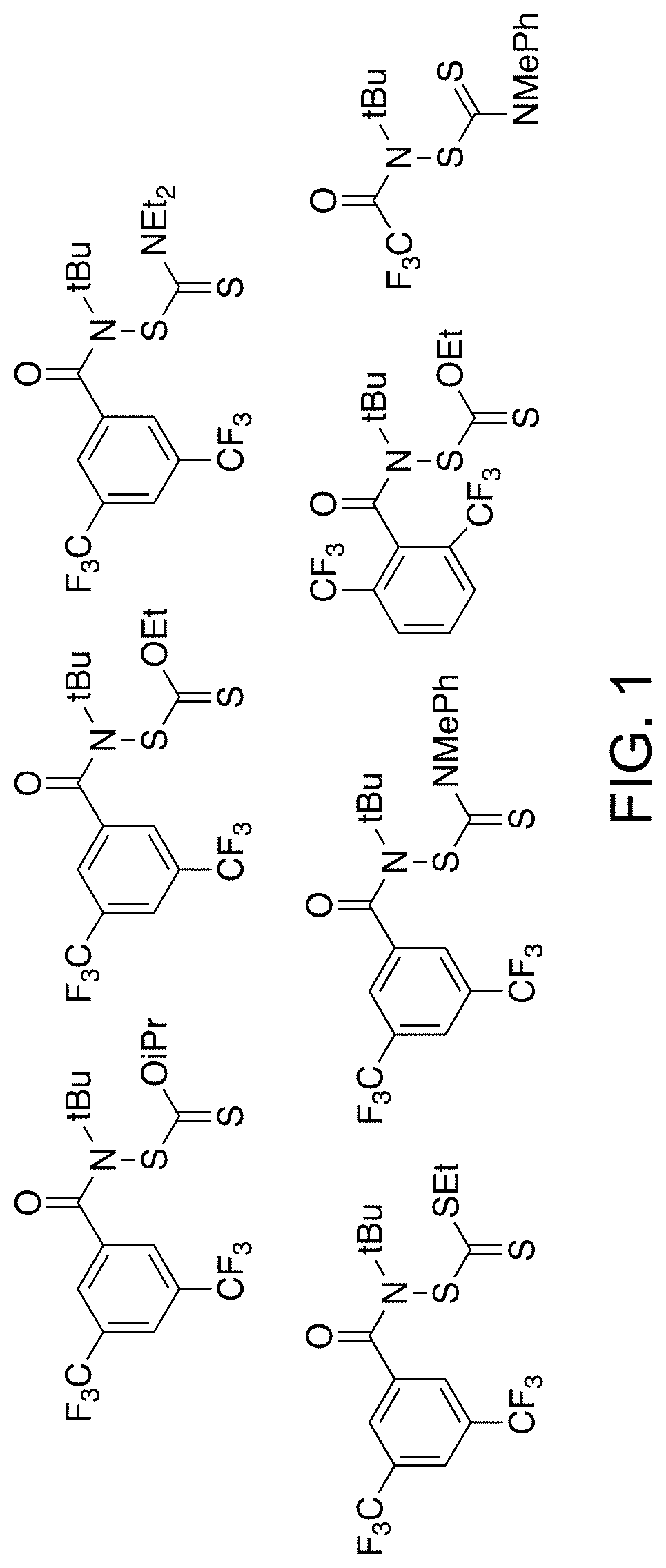Regioselective c-h xanthylation as a platform technology for polymer functionalization
a technology of c-h xanthylation and platform technology, applied in the field of polymer xanthylation and subsequent functionalization of xanthylated polymers, can solve the problems of limiting the ability of composites, adhesives, coatings, etc., to be used in high-performance engineering applications, and limiting their use in other applications
- Summary
- Abstract
- Description
- Claims
- Application Information
AI Technical Summary
Benefits of technology
Problems solved by technology
Method used
Image
Examples
example 1
pproach Using Compound 1
[0502]Xanthyl transfer reagent Compound 1 was used for xanthylation experiments. Compound 1 is pictured below:
[0503]Without being bound by theory, it is believed the reaction proceeds through an amidyl radical reactive intermediate.17 As a soluble and well-defined model for branched polyolefins, polyethylethylene was used which has a number average molecular weight (Mn) of 3.6 kg / mol and a dispersity (D) of 1.24 when compared to polystyrene standards. The polyethylethylene was prepared by the exhaustive reduction of a polybutadiene parent polymer with 90% 1,2 additions. The well-defined structure of the branched polyolefin enabled the visualization of even subtle changes in the Mn and Ð under the reaction conditions by gel permeation chromatography (GPC).
[0504]Without being bound by theory, it is believed that a key the methods described herein is the use of electrophilic nitrogen-centered radicals (prepared from compounds such as those of Formula I) that hav...
example 2
of Compound 1
[0506]Initial studies towards the synthesis of Compound 1 using approaches involving the direct N-xanthylation of amides with strong base were unsuccessful (F. Gagosz, C. Moutrille, S. Z. Zard, Org. Lett. 4:2707-2709 (2002)). However, a new approach to the synthesis of Compound 1 was developed that avoids the use of strongly basic conditions and is also amenable to large-scale preparation. In an embodiment, chlorobenzamide Compound S4 is contacted with potassium ethyl xanthate to yield shelf-stable N-xanthylamide Compound 1 on decagram scale. Additionally, Compound 1 shows no degradation after being stored foil-wrapped at 0° C. for four months. At room temperature in CDCl3 solution in ambient laboratory light, less than 5% degradation is observed after two months.
N-(tert-butyl)-3,5-bis(trifluoromethyl)benzamide (Compound S3)
[0507]
Oxalyl chloride (9.85 mL, 116.23 mmol) was added dropwise to a solution of 3,5-bis(trifluoromethyl)benzoic acid (15 g, 58.11 mmol) in CH2Cl2 / D...
example 3
of Additional Reagents of Formula (I)
[0513]New synthetic routes were developed to prepare reagents of Formula (I) for xanthylation studies (FIG. 1). Similar to the synthesis of Compound 1, functionalized amides were obtained through a chloroamide intermediate that was generated from a carboxylic acid starting material (Scheme 2). Scheme 2 shows approaches for preparing xanthylamides and trithiocarbonylamides.
[0514]Dithiocarbamyl substrates are generally known to be less prone to aminolysis; formation of the amide was accomplished by amide coupling of an amine and an acid (Scheme 3). The synthetic route for the preparation of thiocarbamaylsulfenamides and subsequent amide coupling is shown in Scheme 3. When R=Et2, the yield was 87%. When R=Me, Ph, the yield was 82%.
Reacting thiocarbamylsulfenamide with acetic anhydride afforded dithiocarbamyl trifluoroacetamide, which was used as a functionalizing agent on both polymeric and small molecule substrates (Scheme 4). The preparation route...
PUM
| Property | Measurement | Unit |
|---|---|---|
| wavelength | aaaaa | aaaaa |
| wavelength | aaaaa | aaaaa |
| wavelength | aaaaa | aaaaa |
Abstract
Description
Claims
Application Information
 Login to View More
Login to View More - R&D
- Intellectual Property
- Life Sciences
- Materials
- Tech Scout
- Unparalleled Data Quality
- Higher Quality Content
- 60% Fewer Hallucinations
Browse by: Latest US Patents, China's latest patents, Technical Efficacy Thesaurus, Application Domain, Technology Topic, Popular Technical Reports.
© 2025 PatSnap. All rights reserved.Legal|Privacy policy|Modern Slavery Act Transparency Statement|Sitemap|About US| Contact US: help@patsnap.com



